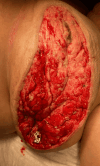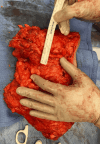Necrotizing Soft Tissue Infection of the Breast: A Unique Presentation of Underlying Invasive Breast Cancer
- PMID: 40761960
- PMCID: PMC12319345
- DOI: 10.7759/cureus.87310
Necrotizing Soft Tissue Infection of the Breast: A Unique Presentation of Underlying Invasive Breast Cancer
Abstract
Necrotizing soft tissue infections (NSTIs) are life-threatening infections that most commonly affect the extremities, perineum, and abdominal wall. These infections begin with the presence of toxin-producing bacteria that invade through a defect in the skin barrier, such as a wound, laceration, trauma, or recent surgical incision. These bacteria cause subsequent tissue destruction and necrosis that can involve the superficial skin, subcutaneous tissue, fascia, and/or muscle. NSTIs can progress quickly, leading to severe sepsis, shock, and even death. NSTIs associated with the breast are an exceedingly rare occurrence, requiring early diagnosis and prompt surgical intervention. In this article, we report the case of a 46-year-old woman with an NSTI of the left breast, which required serial debridement initially, and subsequently a modified radical mastectomy given a pathological diagnosis of invasive ductal carcinoma.
Keywords: breast cancer; critical care; invasive ductal breast carcinoma; necrotizing soft tissue infection; sepsis; surgical oncology.
Copyright © 2025, Rios Herrera et al.
Conflict of interest statement
Human subjects: Informed consent for treatment and open access publication was obtained or waived by all participants in this study. Conflicts of interest: In compliance with the ICMJE uniform disclosure form, all authors declare the following: Payment/services info: All authors have declared that no financial support was received from any organization for the submitted work. Financial relationships: All authors have declared that they have no financial relationships at present or within the previous three years with any organizations that might have an interest in the submitted work. Other relationships: All authors have declared that there are no other relationships or activities that could appear to have influenced the submitted work.
Figures




Similar articles
-
Interventions for necrotizing soft tissue infections in adults.Cochrane Database Syst Rev. 2018 May 31;5(5):CD011680. doi: 10.1002/14651858.CD011680.pub2. Cochrane Database Syst Rev. 2018. PMID: 29851032 Free PMC article.
-
Systemic Inflammatory Response Syndrome.2025 Jun 20. In: StatPearls [Internet]. Treasure Island (FL): StatPearls Publishing; 2025 Jan–. 2025 Jun 20. In: StatPearls [Internet]. Treasure Island (FL): StatPearls Publishing; 2025 Jan–. PMID: 31613449 Free Books & Documents.
-
Necrotizing fasciitis of the breast with extension to the chest wall myofascial layer in a lactating mother: a rare case report.Int J Surg Case Rep. 2025 Jul;132:111460. doi: 10.1016/j.ijscr.2025.111460. Epub 2025 May 26. Int J Surg Case Rep. 2025. PMID: 40450788 Free PMC article.
-
Necrotizing Soft Tissue Infection Secondary to Spinal Hardware Malfunction: A Case Report on Surgical Debridement.Cureus. 2025 Jun 13;17(6):e85917. doi: 10.7759/cureus.85917. eCollection 2025 Jun. Cureus. 2025. PMID: 40656275 Free PMC article.
-
Current diagnosis and management of necrotizing soft tissue infections: What you need to know.J Trauma Acute Care Surg. 2024 Nov 1;97(5):678-686. doi: 10.1097/TA.0000000000004351. Epub 2024 May 1. J Trauma Acute Care Surg. 2024. PMID: 38689406 Review.
References
-
- Necrotizing soft-tissue infection: diagnosis and management. Anaya DA, Dellinger EP. Clin Infect Dis. 2007;44:705–710. - PubMed
-
- Necrotizing fasciitis of the breast: a review of the literature. Cai Y, Cai Y, Shi W, Feng Q, Zhu L. https://www.liebertpub.com/doi/10.1089/sur.2020.071?url_ver=Z39.88-2003&.... Surg Infect (Larchmt) 2021;22:363–373. - PubMed
-
- Imaging of necrotizing fasciitis. Kochkine S, Payne DL, Chung K, Chen D, Bernstein MP, Baxter AB, McMenamy JM. Clin Imaging. 2024;116:110331. - PubMed
-
- Necrotizing soft-tissue infections. Stevens DL, Bryant AE. https://doi.org/10.1056/NEJMra1600673. N Engl J Med. 2017;377:2253–2265. - PubMed
Publication types
LinkOut - more resources
Full Text Sources
